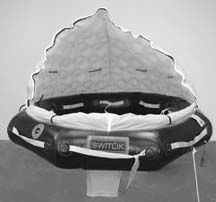by Douglas S. Ritter
When is a raft not quite a life raft? When it’s an “inshore” raft lacking significant capabilities or features normally found on real life rafts. Unfortunately, the distinction isn’t always made clear to the consumer. These rafts, which auto inflate upon deployment, are a lot less expensive and lighter than their full-blown counterparts. We evaluated inshore rafts from Survival Products, Switlik, and Winslow. Prices shown are retail/discount.

Survival Products
Survival Products calls their products “life rafts.” However, they are little more than a single-cell tube with a floor, available in both 4- ($1,095/$988) and 9-person ($1,425/$1,388) sizes, but providing only 3.6 sq. ft. per person. These square rafts have no ballast and only the most minimal entry aids and lifelines—virtually worthless in assisting entry over their 11″ and 12″ tubes. An optional teepee style canopy ($175 and $220 respectively) is available that you must attach and erect via an orally inflated center mast. The canopy is uncomfortable in the extreme. It collapsed in our weather tests and leaked badly. The very compact valise becomes the drogue. Included is a manual bellows pump and cloth bailer, though a variety of survival equipment packages are also available as options. At 12 lbs. and 18 lbs., these are the lightweights of the industry, in more ways than one.
Switlik
Though Switlik is very clear regarding the limited capability of their Rescue Pod ($1,900/$1,500), eschewing the term “raft” entirely, it comes closest to being modestly equipped like a true life raft. The octagonal, single-cell “Emergency Floatation System” is sold as a 4-person raft, but there is only 2.8 sq. ft. per person. That’s the least of any raft we reviewed. There are three rudimentary ballast bags (20 lbs. each, 60 lbs. total) and both interior and exterior lifelines, but no entry aids, though testers didn’t have too much problem getting over the 12″ tube using the lifelines and canopy.
The canopy, deployed furled on the tube, is comprised of six orally inflated triangular sections with retro-reflective trim, which form a bulbous, semi-insulated teepee when inflated and zipped-up. It leaked water at the zipper and the canopy collapsed under minimal water pressure. Once inflated, the canopy could supply a modicum of reserve buoyancy.
An optional orally inflatable drop-in floor is available ($175/$145). A water-activated locator light and raft knife are mounted on the tube. There is an auto-deploying drogue and a kit bag holds a manual bellows pump, a pair of mil-spec repair clamps, and a PRV cap. An ACR Firefly Plus combination flashlight and rescue strobe is a handy accessory. The Pod is available packed in either a valise (33 lbs.) or fiberglass container (44 lbs.).
Winslow
Winslow offers three inshore products, the single-tube, single-cell, octagonal Rescue Raft ($1,395/$1,145) and double-chamber Rescue Raft 2 ($1,945/$1,556), and the double tube, decagonal DualShore ($2,150/$1,720). The Rescue Rafts are available in 4-, 6- and 8-person sizes and the DualShore in 4- through 12-person sizes (prices quoted are 4-person). The four-person rafts weigh in at 16 lbs., 20 lbs., and 21 lbs., respectively, packed in a compact valise. In essence, they have taken their 4 sq. ft. per person coastal and offshore models and stripped them of all but the essentials (including the second chamber in the base model), leaving Winslow’s excellent entry aids to assist entry over the 13″ single tube or much higher double tubes, but there is no ballast or canopy and just a single, top-mounted lifeline. They are clearly designated inshore products with limited capabilities.
You can add any regular Winslow feature or option, such as ballast or a canopy. A unique and potentially valuable capability is that the RR2 and DualShore are retrofittable to full coastal or offshore specification, respectively, if you decide at a later date that you want a more capable survival craft.
Standard equipment includes only Winslow’s spring-loaded manual bellows pump, a raft knife, and a water-activated locator light. A $99 “RescuePack” SEP (survival equipment pack) is available.
Our Picks
We don’t recommend any of these products for use except on protected bays, sounds, and inland waters, though some daredevils have taken off across oceans with them. They are a huge improvement over relying solely upon life vests, however, and will significantly improve your survival chances, especially in cold climates. Even so, they are not real life rafts and you shouldn’t ever consider them as such.
If you’re just after some means to get yourself out of the water, the Winslow Rescue Raft is our pick. Winslow’s quality, full 4 sq. ft. per person capacity, and superior entry aids make the difference and provide good value. We have seen these as low as $995, cash and carry, at some shows, making them an even better value. Its dual-chambered sibling Rescue Raft II is the choice for those who prefer, like us, a measure of redundancy. In many regards, the DualShore is overkill, but if there is an offshore raft in your future, it may make sense.
Switlik’s Rescue Pod is built to their high standards and makes a very nice 2- or 3-person inshore raft. In our opinion, it’s too cramped for four. You’re paying a good deal more, especially if you figure the cost-per-person-capacity for the included canopy (its major advantage), the minimal ballast, and a more complete raft kit.
We’d like to see some signaling equipment such as a flashlight, signal mirror, and whistle included with all these inshore rafts. Switlik has a good head start there. Even then, you need to have at least a minimally equipped abandon ship bag to carry some basic survival gear, especially signaling equipment, unless you upgrade these products with a real SEP.
Contacts- Survival Products, 5614 S.W. 25th St., Hollywood, FL 33203; 954/966-7329, www.survivalproductsinc.com. Switlik Parachute Company, 1325 E. State St., Trenton, NJ 08609; 609/587-3300, www.switlik.com. Winslow LifeRaft Co., 11700 Winslow Dr., Lake Suzy, FL 34266; 800/838-3012, 941/613-6666, www.winslowliferaft.com.







































